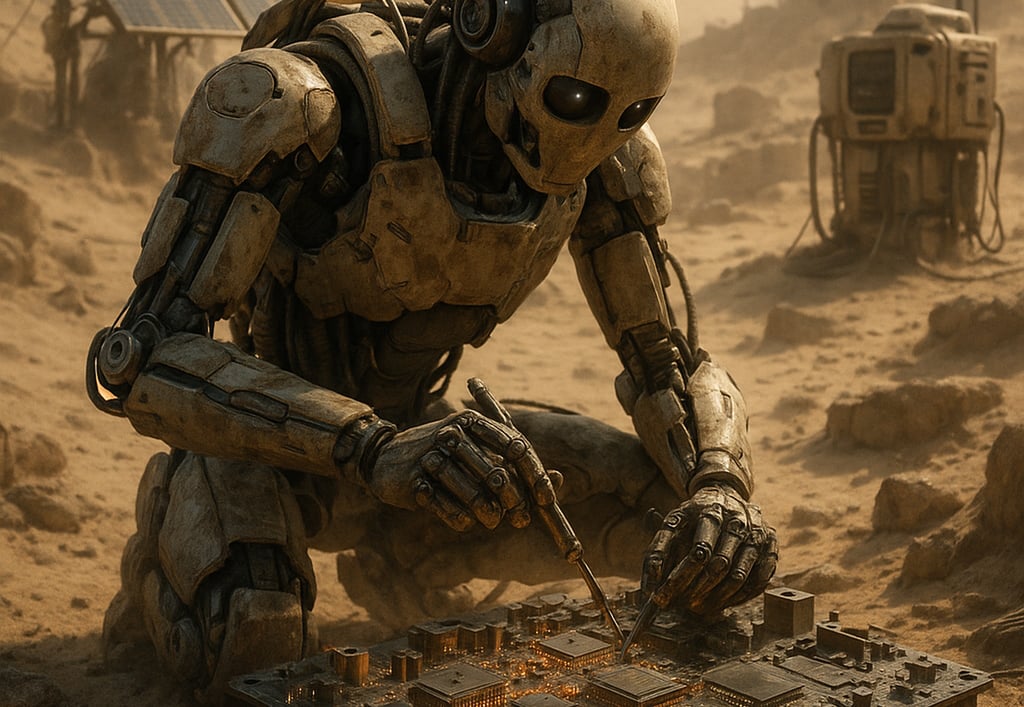Rewiring the Future: How Tuurny's AI is Redefining Electronics Repair
Tuurny, backed by NASA, developed AI for PCB fault detection and repair, enhancing aerospace defense maintenance, reducing reliance on foreign supply chains, and enabling scalable, precise, automation-driven electronics repair.
ARTIFICIAL INTELLIGENCEAIAUTOMATION
Eric Sanders
6/8/20254 min read


In the age of rapid technological advancement, innovation is no longer just about creating new gadgets—it's about rethinking how we sustain and repair what already exists. That’s why the development from NASA-backed startup Tuurny marks a pivotal moment in the future of electronics repair. With artificial intelligence now capable of identifying and fixing faults in printed circuit boards (PCBs), we're entering an era where precision, scale, and national self-reliance aren’t just goals—they're realities.
Tuurny's breakthrough is more than a clever application of AI. It represents a shift in how we deal with some of the most complex challenges in aerospace defense, national manufacturing, and even global supply chain dynamics. The message is clear: intelligent automation isn't just streamlining repair—it's safeguarding the future.
A Personal Glimpse Into the Problem
For decades, the resilience of our technological infrastructure, particularly in aerospace and defense, has hung in a delicate balance. One minor flaw in a PCB—a burnt capacitor, a misaligned trace, a failed solder joint—can delay entire missions or ground critical systems. Yet repairing these faults has remained a painstakingly manual process requiring expert technicians, specialized tools, and, often, replacement components that are manufactured halfway across the globe.
As someone who has worked alongside engineers and witnessed firsthand the fatigue of diagnostic work under a microscope, I understand the toll of traditional repair processes. There's both a physical and mental weight in scanning for faults that are often invisible to the naked eye, then using precise soldering techniques to try and bring a component back to life.
Worse still, the wait times to procure foreign-made parts often meant delays and diminishing returns, especially in industries where time is not a luxury. We’ve all felt the ripple effects—whether it’s a grounded drone, a postponed satellite launch, or a paused production line on a larger mission-critical system. So when I learned about Tuurny’s bold innovation, the impact was immediate. It wasn’t just a technical achievement—it was a revolution in how we think about hardware sustainability. Tuurny's AI-powered system addresses one of the most cumbersome aspects of modern technology: fault detection and repair in printed circuit boards.
What Makes This Solution Stand Out?
- AI-Driven Diagnosis: Tuurny's platform uses machine learning and computer vision to detect anomalies on PCBs—cracks, shorts, corrosion, and other defects—at speeds and accuracies far beyond human capabilities.
- Automated Repair: The system doesn't stop at spotting problems. It corrects them using robotic tools, precise enough to manipulate micro-soldering, replacing components, or re-routing damaged traces.
- Scalability and Flexibility: Unlike traditional repair models bound by human labor and limited shift hours, Tuurny's technology can operate around the clock, working on a nearly limitless variety of PCB architectures.
“The solution enables faster and more accurate fault diagnostics and efficient, scalable repair,” the article notes. “This not only accelerates maintenance processes but mitigates lifecycle and supply chain risks by reducing reliance on foreign component suppliers.”
That last part can't be overstated. National defense and aerospace industries have long suffered under the weight of fragile supply chains. When PCB repairs depend on unavailable foreign components, strategic delays can stack up and compromise entire missions. With Tuurny’s solution, the repair process becomes not just automated, but significantly more resilient.
Lessons Worth Sharing: Innovation for Self-Reliance
Tuurny exemplifies a larger takeaway: innovation that reinforces self-sufficiency is not just valuable—it’s essential.
Here’s what we can learn from their model:
- Automation is Empowerment: By delegating complex diagnostic tasks to AI, engineers are freed up to tackle bigger design and strategy challenges instead of spending hours with microscopes and oscilloscopes.
- Localization Secures Stability: In an era of geopolitical instability and pandemic-era supply chain disruptions, having an in-house repair capability removes a huge point of vulnerability.
- Precision Enables Longevity: Rather than discarding a PCB at the first sign of damage, Tuurny’s tech emphasizes repair over replacement—extending the lifecycle of electronics and reducing waste.
And these lessons stretch well beyond aerospace. Think of how this technology could apply to data centers, automotive electronics, consumer devices, or even medical machinery. Imagine patient monitoring devices in hospitals being auto-diagnosed and repaired overnight by AI systems, without the need for external servicing. The impact is massive.
A Quiet Revolution With Loud Implications
Let’s not overlook who backed this project: NASA. Historically a symbol of ingenuity and long-term vision, NASA’s involvement adds weight to the importance of Tuurny’s discovery. The fact that such a prestigious institution sees value in scalable, AI-driven repair should be a signal to every tech-focused industry.
“The technology holds the potential not only to streamline commercial production and repair but to safeguard critical defense infrastructure through enhanced maintainability.”
We often talk about breakthroughs in AI, but most come in the form of chatbots, image generators, or data sorting tools. Tuurny’s AI, however, interacts with the physical world. It performs surgery on the electrical heart of our machines. And in doing so, it redefines what’s possible in both digital intelligence and hands-on maintenance.
The Future Is Self-Healing
What happens to a world where the machines themselves can sense their own dysfunction and repair it without human intervention?
- Will electronics ever become fully self-healing?
- How might the labor markets adapt as diagnosis and repair automate further?
- Can this tech democratize repair services beyond aerospace and into daily consumer tech?
Tuurny doesn’t just answer a technical problem—it poses bigger philosophical ones. As hardware becomes smarter, more connected, and now self-repairing, the nature of "broken" is changing. And the companies that embrace this shift early will not only save time and money; they’ll thrive in an increasingly autonomous world.
If you're an engineer, a policy-maker, an entrepreneur—or simply someone who’s tired of tossing out broken tech—the question isn’t whether this future is coming. It’s whether we’ll be ready when it arrives.
**What does it mean to build a world where our tools can fix themselves before we even know they’re broken?**
Efficiency
Transform your workflows and reclaim your time.
Contact Us
Need A Custom Solutions? Lets connect!
eric.sanders@thedigiadvantagepro.com
772-228-1085
© 2025. All rights reserved.
